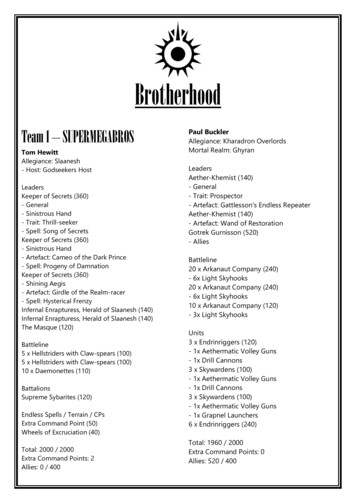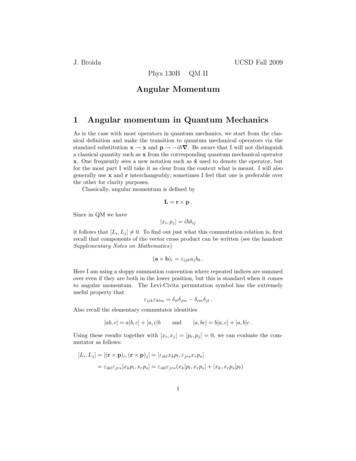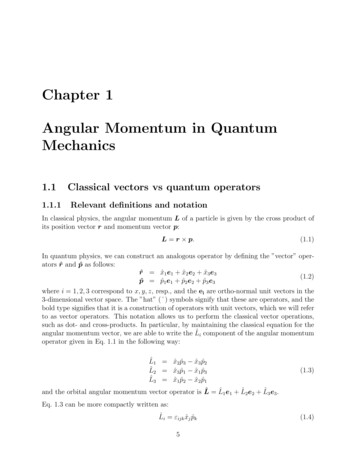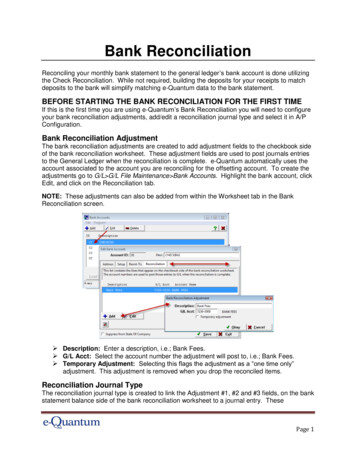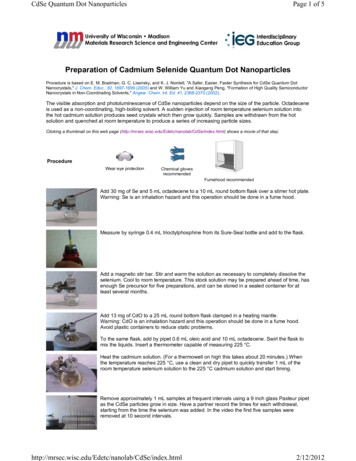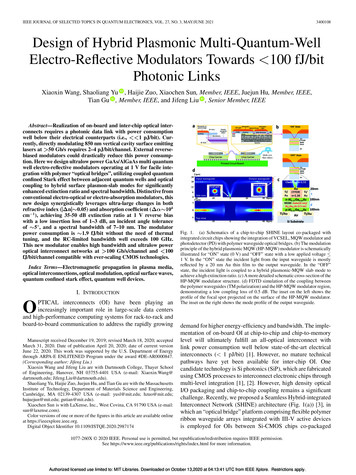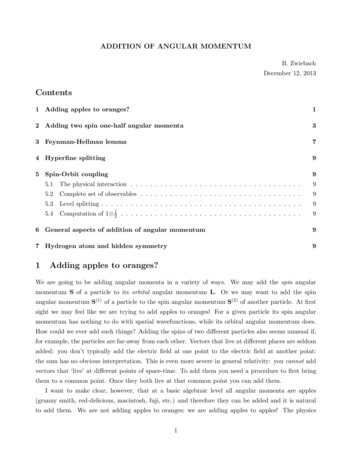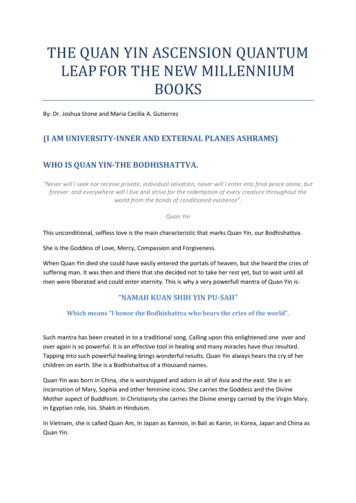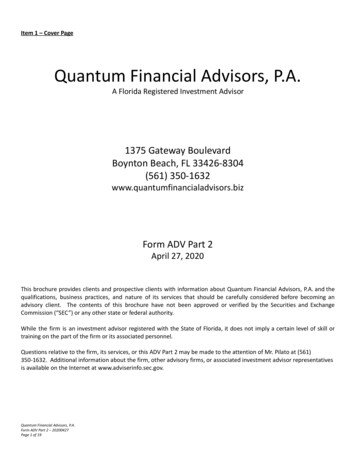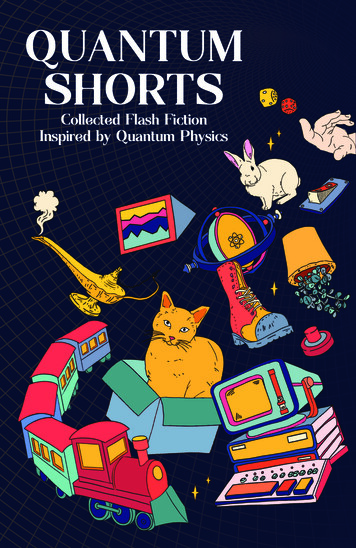
Transcription
QUANTUMSHORTSCollected Flash FictionInspired by Quantum Physics
Quantum Shorts: Collected Flash Fiction Inspired by Quantum Physics Centre for Quantum Technologies, National University of Singapore, 2019Copyrights to individual stories featured in this book are reserved by their respectiveauthors.Cover Illustration & Design N. Syafiqah, 2019ISBN: 978-981-14-3271-2Published by Pagesetters Services Pte Ltd#06-131 Midview City28 Sin Ming LaneSingapore 573972A project byIn no branch of the wavefunction of the universe should you attribute the works of thisbook to anyone other than the authors, make derivatives of this book, or sell this bookfor profit. There is no uncertainty in this statement. Even if no one is observing you,you should do none of the above. But please feel free to share the work with your family,friends, strangers, even your pet cat (although, be warned, some stories might be upsettingfor cats) to help these quantum stories reach as many readers as possible in the multiverse.This work is licensed under aCreative Commons Attribution-NonCommercial-NoDerivatives 4.0 International License.This is a work of fiction.The names, characters and incidents portrayed in it are the work of the authors’imagination.Cover design and layout by N. SyafiqahDigital Conversion by Faris Digital Solutions Pte LtdTypefaces: Agne; LTC Caslon, Agne, Monument ExtendedNational Library Board, Singapore Cataloguing-in-Publication DataName(s): Brooks, Michael, 1970- editor. Hogan, Jenny, 1980- editor. Puah, Xin Yi, editor. National University of Singapore. Centre for Quantum Technologies.Title: Quantum Shorts : collected flash fiction inspired by quantum physics / edited byMichael Brooks, Jenny Hogan, Puah Xin Yi and the Quantum Shorts judges.Description: [Singapore] : Pagesetters Services Pte Ltd, [2019] A project by the Centre for Quantum Technologies,National University of Singapore. Includes index.Identifier(s): OCN 1120100112 ISBN 978-981-14-3270-5 (paperback)Subject(s): LCSH: Flash fiction. Short stories, English. Quantum theory--Fiction.Classification: DDC 823.010836--dc23
QUANTUMSHORTSCollected Flash FictionInspired by Quantum PhysicsEdited byMichael Brooks, Jenny Hogan, Puah Xin Yiand the Quantum Shorts Judges
TABLE OF CONTENTSForewordPrefaceIntroductionUnrequited SignalsTara AbrishamiDiceBetony AdamsMagic Lamp, 2050D. ArcherThe Question TreeD. ArcherHow to Configure Your Quantum DisambiguatorStewart C. BakerThere Was a SunRebecca BaronQuanta RabbitJ. E. BatesI Dreamt of WormsLaura CampbellTill decoherence do us partPeter ChildsCollapseJesus ChuaThe Knight of InfinityBrian Crawford
Why Don't You JustSumit DamChasing ProbabilityGunnar De WinterI, IoniumCharles DittellDon't Die Before You're Dead, Sally WuAndrew Neil GrayFrom the Ruins of BeijingAndrew Neil GrayA Slice of RealityJudy HelfrichQuantopiaJudy HelfrichAnaLiam HoganThe Fraction She Didn't Know She WasJenni JuvonenThe Scent of StrangenessJ. M. KinnearEnd-User AgreementMorgan LongThe Leaning LightAndrew J. Manera
Two wordsNick MaslovThe Cat in the BoxRebecca MontangeBeam TherapyRicky NathvaniThe Entanglement ProposalVina Jie-Min PrasadQuantum ManClifton RumseyThe Relative Uncertainty of Reality: A true story?Daniel SwindlehurstHaniza's SlipstreamAaric Tan Xiang YeowPostmortemAbel James TildaA Future with FortranLily TuraskiThe Qubits of College AcceptanceLily TuraskiIndistinguishableKenton K. YeeSuperposeYuen Xiang Hao
Time ManagementPrzemysław ZańkoAcceptable LossPrzemysław ZańkoIndex by Quantum ConceptsAbout the AuthorsAbout the DesignerList of Stories and their Creative Commons Licences
FOREWORDLet me confess: in my entire academic career, I have neverbeen able to separate my childhood dreams and fantasiesfrom my research. I know, I might have prolonged myadolescence beyond any reasonable limits, but it worksfor me. The wonders of the quantum world, reflected inequations, plots and diagrams, are as addictive as thoseimaginary worlds of seductive beauty that I used to visit inmy dreams.Unfortunately, as we grow up, we are hardly encouragedto use imagination in daily life. The self-improvementgurus stress willpower, grit, self-control or discipline, andthat’s alright, but I think that without imagination andfantasy you will never live your life to the full; you willnever expand your horizons, or come up with new ideas,inventions and discoveries.Let me stress that there is no contradiction betweenimagination and rational thinking; fantasy and logic govery well together. One of the most profound insights intothe structure of reality, the many-worlds interpretation ofquantum theory, proposed by Hugh Everett in 1955, couldonly be discovered by having enough imagination to drawall the logical conclusions from the mathematical formalismof quantum theory.Once you take quantum theory at face value, not as apredictive tool but as an explanation for how the worldreally works, you are led to conclude that our universe isone of many in an infinite ensemble of parallel universesthat physicists have come to call the multiverse.Rumour has it that Everett, who was an avid sciencefiction reader, took his inspiration from Star Maker,a classic science-fiction novel by British writer OlafStapledon, published in 1937, which featured the conceptof the multiverse.Needless to say, following your fantasies in search forexplanations and beauty is not without risk. So many times,I have ended up in a cul-de-sac and taken a while to back off8
and try again, but most times, I was rewarded with freshinsights and deep satisfaction.To be sure, to appreciate the full beauty of quantumtheory you need some technical preparation. It is a bitlike snorkelling and scuba diving. You can observe coralsand fish from the surface, and you can get a pretty goodidea of how beautiful they are, but it takes some technicalknowledge and skills to go for a total immersion and betruly overwhelmed by the beauty of the underwater world.Thus, take this collection of Quantum Shorts as yoursnorkelling introduction into the quantum world. But Ipromise, you will not be disappointed.In pages to come you will find texts that are both thoughtprovoking and beautifully written. They vary in style,composition, maturity, you name it, but to me, they alldazzle with a remarkable dose of “quantum imagination”.And who knows, perhaps you will be inspired to considerthe total immersion: that is, learning quantum theory withall its technicalities. Again, I promise, you will not bedisappointed. But for now, turn the page, relax and enjoy.Artur EkertDirector of the Centre for Quantum Technologies andLee Kong Chian Centennial Professor at the NationalUniversity of Singapore.9
PREFACEIn this book, you will find 37 different short stories from32 different writers inspired by quantum physics in at leastas many different ways. Each of these “Quantum Shorts” isno longer than 1000 words.These stories were entries to a series of Quantum Shortsflash fiction competitions held in 2013, 2015 and 2017. Fromover a thousand entries all told, these few are the prizewinners across the competition’s international open andyouth categories, and all the stories shortlisted in the opencategory.The Quantum Shorts competitions are an initiative of theCentre for Quantum Technologies (CQT) at the NationalUniversity of Singapore, backed by a stellar collectionof partners. We are grateful to Scientific American andNature for their constant support as media partners, TorBooks and Tor.com for working with us in the early years,and our scientific partners around the world.Our thanks in particular for sponsorship of this bookto the Australian Research Council Centre for EngineeredQuantum Systems; the Institute for Quantum Computingat the University of Waterloo in Canada; the Institute forQuantum Information and Matter at Caltech in the UnitedStates; QuantIC, the UK Quantum Technology Hub inQuantum Enhanced Imaging; and QuTech, a collaborationbetween the Delft University of Applied Sciences and Dutchinnovation centre TNO in the Netherlands. We thank theJoint Quantum Institute, a partnership of the Universityof Maryland and the National Institute of Standards andTechnology in the United States, for supporting earliereditions of Quantum Shorts.We also owe a debt of gratitude to our contest judges—the creative physicists, writers and artists—who haveworked with us across the competition over the years todecide the top prizes. For their discerning choices, wethank Mark Alpert, Jennifer Megan Crawford, MarietteDiChristina, Greg Dick, Artur Ekert, Otto Fong, Paweł10
Frelik, Brian Greene, Tania Hershman, Kwek LeongChuan, Jason Erik Lundberg, Clara Moskowitz, MichaelMrak, Patrick Nielsen Hayden, Chad Orzel, Pang KianTiong, Lisa Randall, John Scalzi, Colin Sullivan, Paul Tan,Vlatko Vedral, Eleanor Wong, JY Yang and Yeow Kai Chai.We thank all the experts on our shortlisting panels too,whose job was made difficult by the volume and qualityof the entries each year: Michael Brooks, Julia Cramer,Tobi Day-Hamilton, Tania De Rozario, Andrew Doherty,Matt Edgar, Jenny Hogan, Spiros Michalakis and JodiSzimanski.Our biggest thanks, of course, go to the writers whomake this book worth reading. You will find their namesover the coming pages as you explore the quantum worldwith them, and we have included their biographies at theend of this book.In case you’re wondering what happens to QuantumShorts in the even numbered years, we don’t rest. Thoseyears we hold competitions for short films. We can’t putthose in this book, but you can enjoy all the materialsand make deeper dives into quantum physics at shorts.quantumlah.org.11
INTRODUCTIONHere be monsters—and lots of cats.Human beings have an instinctive fear of the unknown.Scholars who made maps in medieval times used to drawall kinds of mythical monsters onto the areas of their mapswhere no one had ever travelled.The story of quantum theory is, arguably, no different.Its founders—notable names such as Albert Einstein,Erwin Schrödinger, Niels Bohr and Werner Heisenberg—had to navigate unknown territories, and were oftenfearful about what they might find. That’s why Einsteinfamously declared that the idea of quantum entanglement,the counterintuitive link that can exist between quantumparticles, would be better framed as “spooky action at adistance”. He simply didn’t believe it was possible. TheQuantum Shorts authors don’t share his apprehension.Stories that you’ll find in this collection, like “TheEntanglement Proposal” and “Till decoherence do uspart”, reimagine a future where quantum entanglement isan intimate part of our everyday lives.Since Einstein, experiments have shown thatentanglement is not only possible, but it is achievable—anduseful. So is the fact that quantum events seem to occurwithout a cause, something so unthinkable that Einsteinconsidered it akin to letting God “play dice” with theuniverse. Again, though, this strange situation appears tobe exactly how things are in the quantum world.It wasn’t only Einstein that was troubled by quantumreality. Schrödinger was very uncomfortable with thecauseless effects too, while also struggling with the factthat quantum theory allowed him to create a theoreticalscenario describing a cat that is simultaneously dead andalive.This “superposition” of multiple possibilities is oneof the more easily palatable consequences of quantumtheory. Perhaps that is why Schrödinger’s Cat has becomea celebrated quirk of the theory (and inspiration for many12
a Quantum Shorts like “The Cat in the Box” and “TheQubits of College Acceptance”) rather than the motivationfor the theory’s improvement that Schrödinger intended.After all, the work of Prince Louis de Broglie gavequantum things properties that exist in a near-infinite arrayof abstract dimensions of space, an attribute that makes adead-and-alive cat seem almost reasonable.De Broglie’s extra dimensions became less abstract,but no less mind-boggling, when Hugh Everett IIIproposed that they were the seeds of alternate universesno less real than our own. You’ll encounter this idea ofalternate universes in the very first story of this collection,“Unrequited Signals”. For more stories about alternateuniverses, you may want to jump to stories including“Don’t Die Before You’re Dead, Sally Wu”, “Ana” and“The Fraction She Didn’t Know She Was”.Everett III’s “Many-Worlds” interpretation of quantummechanics stands in contrast to Niels Bohr’s views. Bohrdeclared that physicists shouldn’t even discuss things thatweren’t directly measured or observed in experiments,putting the act of measurement centre stage (without everdefining what constitutes a measurement, admittedly).Since these pioneers of the early 20th Centurybequeathed us these ideas, researchers have exploredthem further. The results are a host of Nobel prizes anda panoply of technologies that have changed people’s lives.Quantum physics was essential to the understanding ofmaterials that led to all the semiconductor chips and laserspowering today’s computer age. Now its unique featuresare being harnessed for a “quantum age” of super-precisesensors, ultra-secure communications and supremelypowerful quantum computers. You’ll see a glimpse of thepossibilities that these quantum technologies might bringin stories such as “From the Ruins of Beijing” and “EndUser Agreement”.If you’d like to navigate the stories of this collection13
by their quantum ideas, the index at the end of the bookcould help you chart your journey. It’s not exhaustive,but it classifies the Quantum Shorts according to some ofthe bigger concepts in quantum physics. You could readall the stories about superposition, for example, beforemoving on to stories that question reality. To learn moreabout the scientific concepts, you can visit https://shorts.quantumlah.org/quantum-theories.The outer territories of the quantum map have alwaysdrawn explorers and creators, imaginative minds read
end of this book. In case you’re wondering what happens to Quantum Shorts in the even numbered years, we don’t rest. Those years we hold competitions for short films. We can’t put those in this book, but you can enjoy all the materials and make deeper dives
